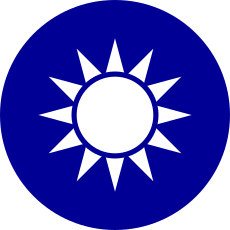National Unification Council
|
國家統一委員會 Guójiā tǒngyī wěiyuánhuì | |
| Agency overview | |
|---|---|
| Formed | October 7, 1990 |
| Dissolved | February 27, 2006 |
| Jurisdiction |
|
| Parent agency | Office of the President of the Republic of China |
| National Unification Council | |||||||
| Traditional Chinese | 國家統一委員會 | ||||||
|---|---|---|---|---|---|---|---|
| Simplified Chinese | 国家统一委员会 | ||||||
| |||||||
The National Unification Council, established on October 7, 1990,[1] was a governmental agency of the Republic of China on Taiwan which is now defunct but whose formal aim was to promote reintegration of mainland China into the Republic of China.
In February 1991, the council drafted the Guidelines for National Unification, which outlined a three-phase approach for Chinese unification. The Guidelines called for Beijing to democratize and become more developed as the precondition for serious talks about steps toward eventual integration.[2]
The Council was suspended in early 2006.[3]
Establishment
The National Unification Council was established under the direct oversight of the Office of the President by President Lee Teng-hui.[4] It first met on October 7, 1990, with 30 members. Membership extended to government officials, political party leaders, industrialists, civic leaders, scholars and journalists.[1] The National Unification Council held 14 meetings from its founding to April 8, 1999.[5]
In February 1991, the council drafted the Guidelines for National Unification, which outlined a three-phase approach for Chinese unification.[2] The Guidelines called for Beijing to democratize and become more developed as the precondition for serious talks about steps toward eventual integration.[2][4] The guidelines stipulate that "both the mainland and Taiwan areas are parts of Chinese territory. Helping to bring about national unification should be the common responsibility of all Chinese people."[5]
The meaning of "one China" adopted by the "national unification council" on August 1, 1992 says that "both sides of the Taiwan Straits agree that there is only one China. However, the two sides of the Straits have different opinions as to the meaning of 'one China'." This would later known as the 1992 consensus.[5]
Abolition
The council had already been out of operation under the administration of Chen Shui-bian since 2000, who has leaned towards Taiwanese independence and opposed Chinese reunification. At the same time, in his "Four Noes and One Without" policy, Chen promised not to formally abolish the Council or the Guidelines for National Unification, in order to allay international concern about his possible moves toward declaring independence.
In his lunar new year speech in 2006 President Chen Shui-bian instructed the Democratic Progressive Party to begin formal debate on the permanent abolition of the National Unification Council and the guidelines set out therein.[6] On February 27, 2006, Chen formally announced that the council would "cease to function" and its guidelines would "cease to apply".[7] President Chen Shui-bian declared that the Guidelines for National Unification had “ceased to apply” because they had been drawn up by an ad hoc presidential commission in the days before citizens had the right to elect their leader and make their voices effectively heard. Moreover, the framers of the guidelines had premised them on a “one-China principle” and the presumption of eventual unification without consulting the people of Taiwan.[4]
The Council was suspended in early 2006, with President Chen Shui-bian remarking:[3]
“The National Unification Council will cease to function. No budget will be ear-marked for it and its personnel must return to their original posts...The National Unification Guidelines will cease to apply. In accordance with procedures, this decision will be transmitted to the Executive Yuan for notice.”
Chen had previously called for the NUC to be “abolished” but later toned this down to "cease to function". The government was ambiguous on whether “cease to function” was the same as “abolish”.
There have been calls for President Ma Ying-jeou to reinstate the National Unification Council, with Taiwan newspaper The China Post remarking in a commentary:[8]
The best and easiest way to show his sincerity is to reinstate the National Unification Council made to cease to function by President Chen. Or to sign a peace accord with Hu Jintao, General Secretary of the Communist Party of China.
See also
- Cross-Strait relations
- Political status of Taiwan
- Mainland Affairs Council, Republic of China
- Taiwan Affairs Office, People's Republic of China
References
- 1 2 "Unification Council To Debut". Taiwan Today/Taiwan Info. 4 October 1990. Archived from the original on 4 October 1990. Retrieved 1 June 2016.
- 1 2 3 "Historical Overview". 16 April 2008. Retrieved 1 June 2016.
- 1 2 "President: NUC to cease to function". China Post. February 28, 2006. Retrieved October 3, 2012.
- 1 2 3 "Cross-Strait Relations". Official Portal Website of the Republic of China, Taiwan. Retrieved 16 March 2016.
- 1 2 3 http://english.peopledaily.com.cn/200602/28/eng20060228_246451.html
- ↑
- BBC News: Alarm at hint to scrap Taiwan body, 2006-02-06
- ↑ BBC News: Taiwan scraps unification council, 2006-02-27
- ↑ President Ma pays homage in person to the Yellow Emperor, China Daily Post
